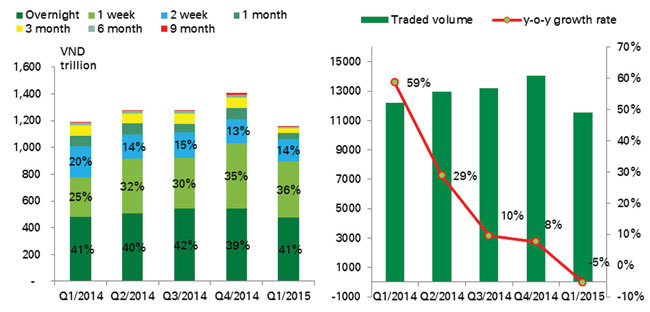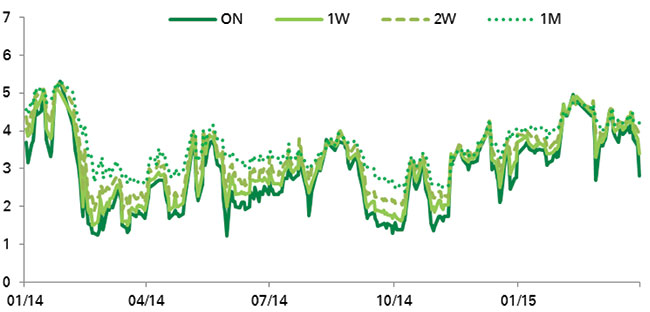Liquidity shortage pressurises rates

According to a report from the State Bank of Vietnam (SBV), the total trading volume for the first quarter reached $54 billion, down 17.81 per cent from the previous quarter and 5.3 per cent over a year. Short tenors were more active than long-term maturities. Overnight bonds recorded VND476,018 billion ($22 billion) of trading, accounting for 41 per cent of the total, while one-week tenors posted at VND418,109 billion ($20 billion) and contributed to 36 per cent of total traded value. Banks conducted lending and borrowing transactions via the interbank market in order to meet the minimum reserve requirement and avoid a shortage of short-term liquidity.
Strong credit growth was a leading factor in the decline in bond trading as banks diverted funds from the bond market to make loans. Year-to-date credit growth reached 1.91 per cent through March-end. This was a substantial improvement over the period from 2011 to 2014, when credit growth was abnormally negative during the first quarter of the year. As described in the report on macro-economic conditions in May and for the first five months released by the National Financial Supervision Commission, as of May 20, credit of the whole market grew at 4.26 per cent, which was nearly four times higher than last year.

During 2014, banks mobilised funds in the interbank market to invest in the bond market for gains. This method of making money continued into 2015. Although the primary bond market deteriorated, with issuance volume declining 14 per cent to only VND69,941 billion ($3.3 billion), the secondary market still experienced a bright note. Total trading of government- and guaranteed-government bonds in the secondary market reached VND236,628 billion ($11 billion), surging 64 per cent year-over-year. Bond yields followed the downtrend during the first quarter, which attracted investors. This had negative impacts on the supply side in the interbank market.
The supply side in the interbank market was limited, which was caused by the strength of the US dollar making the foreign market upbeat. Signs of US economic recovery and the possibility of the FED raising interest rates boosted the dollar against other currencies. At the same time, Vietnam’s trade balance retreated to a deficit during the first three months. The trade deficit in March reached nearly $1.4 billion, which expanded the total of deficit for the first quarter up to $2.4 billion. This, consequently, increased the demand for such notes.
Strong credit growth and the active foreign exchange market restricted the supply of lending in the interbank market. At the same time, borrowing demand increased to meet the needs of customers during the long-term holidays and put pressure on interest rates to increase.
According to Bloomberg, interest rates increased across most tenors of less-than-one-month during the first quarter compared with last year: overnight (3.9 per cent , +120 basis points) , one week (4 per cent; +110 basis points), two weeks (4.1 per cent, +100 basis points) and one month (4.3 per cent , +100 basis points). In particular, before the Tet holiday, the overnight interest rate reached 5.3 per cent, the highest level since early 2013.
By Nguyen Bao Ngoc Research Department VPBank Securities
What the stars mean:
★ Poor ★ ★ Promising ★★★ Good ★★★★ Very good ★★★★★ Exceptional
Latest News
More News
- The promotion of ESG via banking (November 21, 2024 | 09:32)
- Standard Chartered committed to Vietnam’s financial success (November 21, 2024 | 09:24)
- Full ESG adoption the priority for Agribank (November 21, 2024 | 09:07)
- Banks entice youth with tech advances (November 21, 2024 | 08:00)
- Banks shaping the future as business advisors (November 20, 2024 | 21:00)
- ESG represents a shift towards sustainability for banks (November 20, 2024 | 13:00)
- GGGI supports Vietcombank’s debut of $80 million green bonds (November 20, 2024 | 11:20)
- SHB and the ESG journey: creating social value in every step (November 19, 2024 | 15:00)
- Banking sector contributes to ESG, green growth, and sustainable development (November 19, 2024 | 14:42)
- ESG implementation in banking: from awareness to action (November 19, 2024 | 12:08)

















 Mobile Version
Mobile Version